Zeo Sleep Monitor
In many blog-posts I'm going to be talking about some devices that I use to monitor my sleep. So I thought it best to explain a bit about them. The first one is the Zeo.
There are two flavours of Zeo, a bedside unit and a new mobile version that pairs with your smartphone.
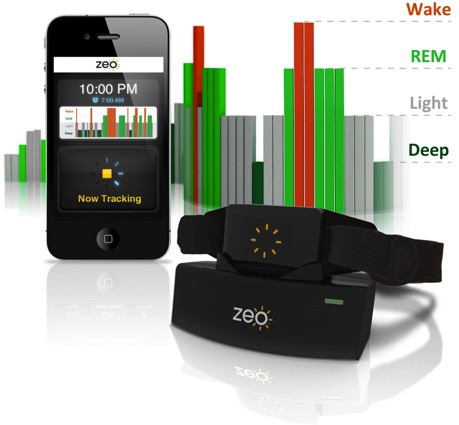
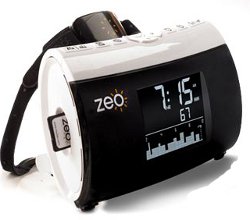
Both devices consist of a wireless headband containing fabric electrodes which are used to measure your brainwaves using EEG technology. Previously EEGs were confined to sleep laboratories and hospitals. They involved gluing electrodes onto your scalp and connecting them to a computer in order to detect the voltage changes that take place in your brain. Interpreting these EEGs is a skill in itself.
During a full polysomnography sleep study, a sleep technician will manually look at each 30 second chunk of data (epoch) from the EEG (then combine it with data from what your eyes were doing and how tense your muscles were) in order to determine which stage of sleep you are in. Zeo is much neater and doesn't involve glue or wires.
A typical night with Zeo goes something like this:
- When you are ready to sleep, remove the headband from it's magnetic dock/charger
- Place the headband on your head with the block roughly central on your forehead
- Wait for the little symbol of a head to illuminate (that means it has detected a brainwave pattern - always a relief)
- Sleep
- Wake, remove and re-dock headband
Both versions allow you to instantly see how you slept last night but you can also upload and view the data via the Zeo website. The site allows greater analysis of how you slept; you can also complete a sleep journal detailing coffee and alcohol intake, your "morning feel" and various other factors to help you see a cause-and-effect relationship between them and how you sleep.
A device that reads your brainwaves... you know you want one. This is where you can get them from in the UK: http://myzeo.co.uk/
So, what does the Zeo actually measure?
As previously said, it uses an EEG, combined with an EOG (eye movements) and EMG (muscle tone) to determine which state of sleep you are in. It then presents this to you in a colourful graph called a hypnogram.
Whereas a sleep technician looks at every 30 seconds, Zeo examines every second of data and makes a decision, it then amalgamates these into 30 second chunks using a proprietary scoring system.
The makers of Zeo have released a special firmware for the bedside unit that allows you to plug a computer into the port on the back and see the actual EEG and play it back in the morning. You can see all the little blips and squiggles and how they relate to your sleep.
This, for example, is a "Sleep Spindle" it signifies that I was in stage 2 sleep...
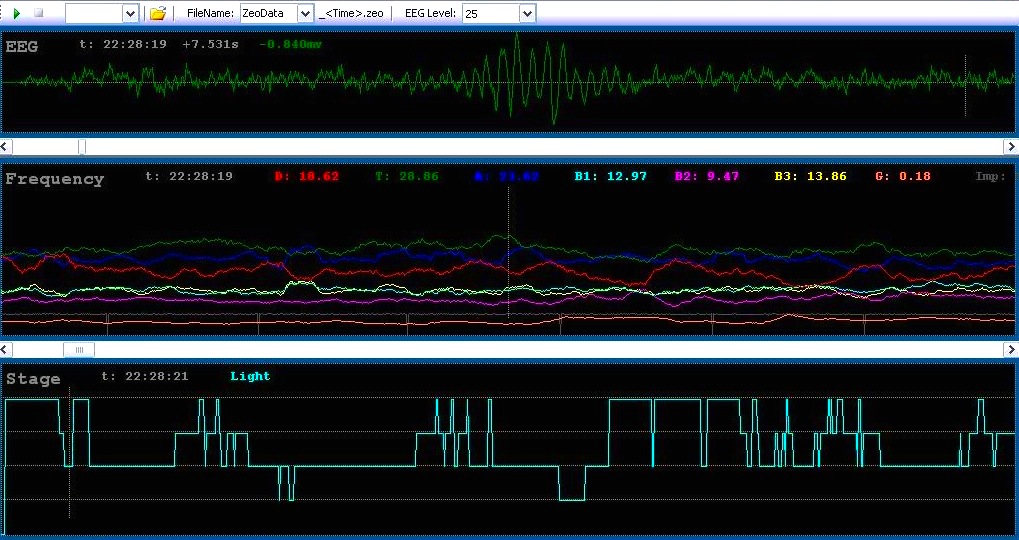
Sleep consists of cycles of deep, light, wake and REM (Rapid Eye Movement). On a formal hypnogram you may see these listed as an N and a number. The N simply means Non-REM. N1 and N2 are considered to be light sleep. N3 (and sometimes N4) are considered to be deep sleep.
Early in the night is when you get the most deep sleep, which then decreases through the night and is "replaced" with increasing amounts of REM
Hence, a normal hypnogram (sleep stage graph) should look something like this:
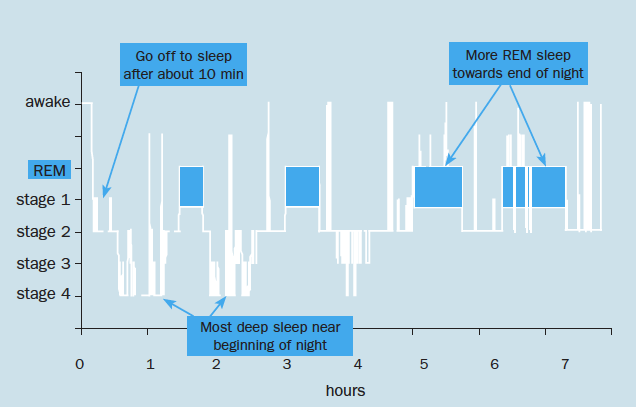
Graph taken from "A good night's sleep part one: Normal Sleep" by Dr Sue Wilson.
"Nursing & Residential Care", November 2008
Zeo's hypnograms display data at resolution of 5 minutes. The 30 second resolution graph is available by exporting the data into a spreadsheet program.
This is one of my recent hypnograms from Zeo, and as you can see it's a mess...
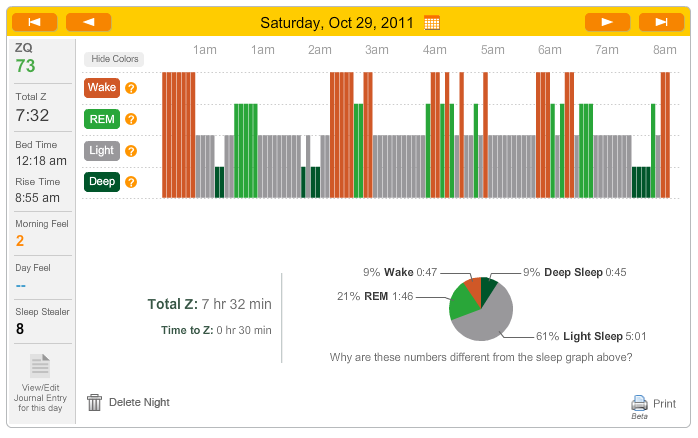
That's where the Zeo's journal comes in... WHY is it a mess? Too much coffee in the afternoon? Too much wine in the evening? Is the room too warm? Do I always wake up at the same time in the night? Why is that? Could it be the heating making noises? etc etc.
By looking at the patterns, you can aim to work out why your night is disrupted (if it is). If you are one of the lucky ones who seem to sleep normally then you can aim to improve on that sleep to make sure you feel bright and energetic in the mornings.
What's wrong with my graph?
Looking at the the night shown above, there are a couple of things that jump out:
- Deep sleep - not enough of it, and doesn't follow the pattern of decreasing through the night. This is clear because my body obviously tried to catch-up on deep sleep at 7:30am!
- I have WASO (Wake after sleep onset), but it seems that they are not random, they seem to be clustered around what should be solid chunks of REM.
These REM disturbances are what I believe leads to episodes of sleep paralysis. I will do a blog post on that later, but there is a good article on Wikipedia about it here: http://en.wikipedia.org/wiki/Sleep_paralysis
So all in all, much to improve on.
I did suspect that I had REM related issues. Maybe a small part of my son's condition is hereditary? Maybe not, maybe it's just coincidence.
For the 10 years that it took to get my son's sleep and breathing under control I was forever listening out for his oxygen alarm. He would stop breathing during REM sleep and the alarm would sound to alert me to it.
I'd then wake up, glance at the alarm on the camera that I'd installed and then go in to rouse him from sleep and get him to breathe again.
This would happen many times a night. Children have a lot of REM!
Maybe in some way my brain had adapted to not be quite asleep, forever on the lookout for my son's alarm that everyone else in the house slept through (including him)!
My son's breathing is now regulated by BiPAP (A breathing machine that delivers alternating pressures of air via a mask - more about that in another post). That started about 6 months ago, so I thought I would have settled down into a decent sleep routine now.
I decided to explore and used some of the cameras and monitors that I had used for my son on myself. After a couple of nights I now have a fair idea of why I wake in REM. So, I've decided to be a bit more disciplined about collecting data and recording what I'm up to.
This week I'll be gathering data for 5 nights (Mon - Fri) and will post the data and its mean as a baseline for my sleep, then I am going to try a different method of "fixing it" every 5 nights (Mon - Fri) and average for consistency.
I'll blog the results as I'm going along.
Next post: baseline sleep scores.
 Hypnagogia Blog
Hypnagogia Blog
Reader Comments (1)
Any update regarding your experience with the Zeo?